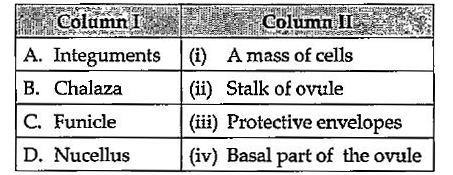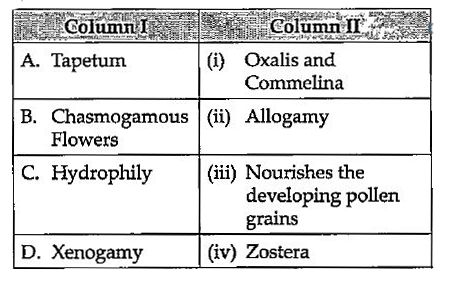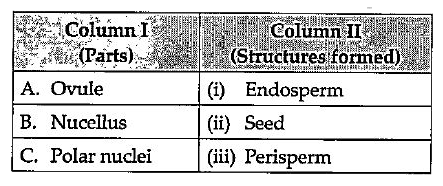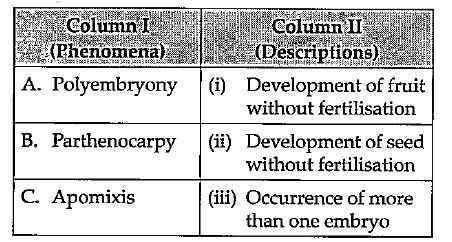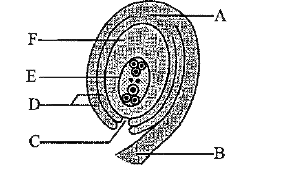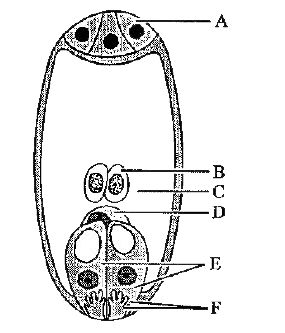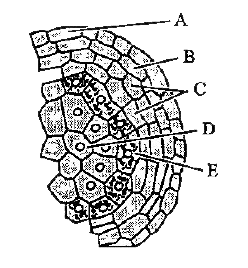SOURCE BASED QUESTIONS from SRIJAN BIOLOGY (ENGLISH) SEXUAL REPRODUCTION IN FLOWERING PLANTS for Class 12
| Class 12 | BIOLOGY |
| Chapter | SEXUAL REPRODUCTION IN FLOWERING PLANTS |
| SRIJAN BIOLOGY (ENGLISH) | SOURCE BASED QUESTIONS |
| Medium | English |
| Academic Year | 2023-2024 |
Question 19
The given below are the steps performed in an artificial hybridisation programme in plants with bisexual flowers.
(i) Re-bagging
(ii) Emasculation
(iii) Dusting the pollen on stigma
(iv)Bagging
(v) Collection of pollen grains from male parent
(vi) Selection of male and female parent plants
Select the correct option with the correct sequence of these events.View SolutionQuestion 26
Read the following statements about self - incompatibility and select the option with correct statements.
(i) It is a device to prevent inbreeding
(ii) This is a genetic mechanism
(iii) It ensures cross-fertilisation
(iv) It prevents self-pollen from fertilising the ovules by inhibiting pollen germination of pollen tube growth in the pistilView SolutionQuestion 67
Read the passages and answer the questions that follow:
A typical stamen shows two important parts - the long and slender stalk called the filament, and the terminal generally bilobed structure called the anther. The proximal end of the filament is attached to the thalamus or the petal of the flower. The number and length of stamens are variable in flowers of different species.
A typical angiosperm anther is bilobed with each lobe having two theca, i.e., they are dithecous.
Often a longitudinal groove runs lengthwise separating the theca. The bilobed nature of an anther is very distinct in the transverse section of the anther. The anther is a four-sided (tetragonal) structure consisting of four microsporangia located at the corners, two in each lobe. The microsporangia develop further and become pollen sacs. They extend longitudinally all through the length of an anther and are packed with pollen grains.
The long and slender stalk of a stamen is called:View SolutionQuestion 68
Read the passages and answer the questions that follow:
A typical stamen shows two important parts - the long and slender stalk called the filament, and the terminal generally bilobed structure called the anther. The proximal end of the filament is attached to the thalamus or the petal of the flower. The number and length of stamens are variable in flowers of different species.
A typical angiosperm anther is bilobed with each lobe having two theca, i.e., they are dithecous.
Often a longitudinal groove runs lengthwise separating the theca. The bilobed nature of an anther is very distinct in the transverse section of the anther. The anther is a four-sided (tetragonal) structure consisting of four microsporangia located at the corners, two in each lobe. The microsporangia develop further and become pollen sacs. They extend longitudinally all through the length of an anther and are packed with pollen grains.
The terminal generally bilobed structure of stamen is called: View SolutionQuestion 69
Read the passages and answer the questions that follow:
A typical stamen shows two important parts - the long and slender stalk called the filament, and the terminal generally bilobed structure called the anther. The proximal end of the filament is attached to the thalamus or the petal of the flower. The number and length of stamens are variable in flowers of different species.
A typical angiosperm anther is bilobed with each lobe having two theca, i.e., they are dithecous.
Often a longitudinal groove runs lengthwise separating the theca. The bilobed nature of an anther is very distinct in the transverse section of the anther. The anther is a four-sided (tetragonal) structure consisting of four microsporangia located at the corners, two in each lobe. The microsporangia develop further and become pollen sacs. They extend longitudinally all through the length of an anther and are packed with pollen grains.
A typical angiosperm anther is bilobed with each lobe having two theca, i.e., they are: View SolutionQuestion 70
Read the passages and answer the questions that follow:
A typical stamen shows two important parts - the long and slender stalk called the filament, and the terminal generally bilobed structure called the anther. The proximal end of the filament is attached to the thalamus or the petal of the flower. The number and length of stamens are variable in flowers of different species.
A typical angiosperm anther is bilobed with each lobe having two theca, i.e., they are dithecous.
Often a longitudinal groove runs lengthwise separating the theca. The bilobed nature of an anther is very distinct in the transverse section of the anther. The anther is a four-sided (tetragonal) structure consisting of four microsporangia located at the corners, two in each lobe. The microsporangia develop further and become pollen sacs. They extend longitudinally all through the length of an anther and are packed with pollen grains.
In tetragonal structure of anther how many microsporangia are present ?View SolutionQuestion 71
A typical microsporangium in transverse section appears near circular in outline. It is generally surrounded by four wall layers - the epidermis, endothecium, middle layers and the tapetum. The outer three wall layers perform the function of protection and help in dehiscence of anther to release the pollen. The innermost wall layer is the tapetum. It nourishes the developing pollen grains. When the anther is young, a group of compactly arranged homogenous cells called the sporogenous tissue occupies the centre of each microsporangium. As the anther develops, the cells of the sporogenous tissue undergo meiotic divisions to form microspore tetrads.
As each cell of the sporogenous tissue is capable of giving rise to a microspore tetrad. Each one is a potential pollen or microspore mother cell. The process of formation of microspores from a pollen mother cell (PMC) through meiosis is called microsporogenesis. The microspores, as they are formed, are arranged in a cluster of four cells-the .microspore tetrad.
If we cut Microsporangium transversely how many layers are found in the wall of Microsporangium?View SolutionQuestion 72
A typical microsporangium in transverse section appears near circular in outline. It is generally surrounded by four wall layers - the epidermis, endothecium, middle layers and the tapetum. The outer three wall layers perform the function of protection and help in dehiscence of anther to release the pollen. The innermost wall layer is the tapetum. It nourishes the developing pollen grains. When the anther is young, a group of compactly arranged homogenous cells called the sporogenous tissue occupies the centre of each microsporangium. As the anther develops, the cells of the sporogenous tissue undergo meiotic divisions to form microspore tetrads.
As each cell of the sporogenous tissue is capable of giving rise to a microspore tetrad. Each one is a potential pollen or microspore mother cell. The process of formation of microspores from a pollen mother cell (PMC) through meiosis is called microsporogenesis. The microspores, as they are formed, are arranged in a cluster of four cells-the .microspore tetrad.
Which of the following is the innermost wall layer of Microsporangium?View SolutionQuestion 73
A typical microsporangium in transverse section appears near circular in outline. It is generally surrounded by four wall layers - the epidermis, endothecium, middle layers and the tapetum. The outer three wall layers perform the function of protection and help in dehiscence of anther to release the pollen. The innermost wall layer is the tapetum. It nourishes the developing pollen grains. When the anther is young, a group of compactly arranged homogenous cells called the sporogenous tissue occupies the centre of each microsporangium. As the anther develops, the cells of the sporogenous tissue undergo meiotic divisions to form microspore tetrads.
As each cell of the sporogenous tissue is capable of giving rise to a microspore tetrad. Each one is a potential pollen or microspore mother cell. The process of formation of microspores from a pollen mother cell (PMC) through meiosis is called microsporogenesis. The microspores, as they are formed, are arranged in a cluster of four cells-the .microspore tetrad.
Which among the following layers of microsporangium nourishes the developing pollen grains?View SolutionQuestion 74
A typical microsporangium in transverse section appears near circular in outline. It is generally surrounded by four wall layers - the epidermis, endothecium, middle layers and the tapetum. The outer three wall layers perform the function of protection and help in dehiscence of anther to release the pollen. The innermost wall layer is the tapetum. It nourishes the developing pollen grains. When the anther is young, a group of compactly arranged homogenous cells called the sporogenous tissue occupies the centre of each microsporangium. As the anther develops, the cells of the sporogenous tissue undergo meiotic divisions to form microspore tetrads.
As each cell of the sporogenous tissue is capable of giving rise to a microspore tetrad. Each one is a potential pollen or microspore mother cell. The process of formation of microspores from a pollen mother cell (PMC) through meiosis is called microsporogenesis. The microspores, as they are formed, are arranged in a cluster of four cells-the .microspore tetrad.
What is called a group of compactly arranged homogeneous cells of anther?View SolutionQuestion 75
A typical microsporangium in transverse section appears near circular in outline. It is generally surrounded by four wall layers - the epidermis, endothecium, middle layers and the tapetum. The outer three wall layers perform the function of protection and help in dehiscence of anther to release the pollen. The innermost wall layer is the tapetum. It nourishes the developing pollen grains. When the anther is young, a group of compactly arranged homogenous cells called the sporogenous tissue occupies the centre of each microsporangium. As the anther develops, the cells of the sporogenous tissue undergo meiotic divisions to form microspore tetrads.
As each cell of the sporogenous tissue is capable of giving rise to a microspore tetrad. Each one is a potential pollen or microspore mother cell. The process of formation of microspores from a pollen mother cell (PMC) through meiosis is called microsporogenesis. The microspores, as they are formed, are arranged in a cluster of four cells-the .microspore tetrad.
What type of cell division takes place in the sporogenous tissue to form microspore tetrads?View SolutionQuestion 76
The pollen grains represent the male gametophytes. Pollen grains are generally spherical measuring about 25-50 micrometers in diameter. It has a prominent two-layered wall. The hard outer layer called the exine is made up of sporopollenin which is one of the most resistant organic material known. It can withstand high temperatures and strong acids and alkali. No enzyme that degrades sporopollenin is so far known. Pollen grain exine has prominent apertures called germ pores where sporopolienin is absent. Pollen grains are well preserved as fossils because of the presence of sporopollenin. The exine exhibits a fascinating array of patterns and designs. The inner wall of the pollen grain is called the intine. It is a thin and continuous layer made up of cellulose and pectin. The cytoplasm of pollen grain is surrounded by a plasma membrane. When the pollen grain is mature it contains two cells, the vegetative cell and generative cell. The vegetative cell is bigger, has abundant food reserve and a large irregularly shaped nucleus. The generative cell is small and floats in the cytoplasm of the vegetative cell.
Which of the following structures is represented by pollen grains?View SolutionQuestion 77
The pollen grains represent the male gametophytes. Pollen grains are generally spherical measuring about 25-50 micrometers in diameter. It has a prominent two-layered wall. The hard outer layer called the exine is made up of sporopollenin which is one of the most resistant organic material known. It can withstand high temperatures and strong acids and alkali. No enzyme that degrades sporopollenin is so far known. Pollen grain exine has prominent apertures called germ pores where sporopolienin is absent. Pollen grains are well preserved as fossils because of the presence of sporopollenin. The exine exhibits a fascinating array of patterns and designs. The inner wall of the pollen grain is called the intine. It is a thin and continuous layer made up of cellulose and pectin. The cytoplasm of pollen grain is surrounded by a plasma membrane. When the pollen grain is mature it contains two cells, the vegetative cell and generative cell. The vegetative cell is bigger, has abundant food reserve and a large irregularly shaped nucleus. The generative cell is small and floats in the cytoplasm of the vegetative cell.
What is the general form and size of pollen grains?View SolutionQuestion 78
The pollen grains represent the male gametophytes. Pollen grains are generally spherical measuring about 25-50 micrometers in diameter. It has a prominent two-layered wall. The hard outer layer called the exine is made up of sporopollenin which is one of the most resistant organic material known. It can withstand high temperatures and strong acids and alkali. No enzyme that degrades sporopollenin is so far known. Pollen grain exine has prominent apertures called germ pores where sporopolienin is absent. Pollen grains are well preserved as fossils because of the presence of sporopollenin. The exine exhibits a fascinating array of patterns and designs. The inner wall of the pollen grain is called the intine. It is a thin and continuous layer made up of cellulose and pectin. The cytoplasm of pollen grain is surrounded by a plasma membrane. When the pollen grain is mature it contains two cells, the vegetative cell and generative cell. The vegetative cell is bigger, has abundant food reserve and a large irregularly shaped nucleus. The generative cell is small and floats in the cytoplasm of the vegetative cell.
What is called the hard outer layer of a pollen grain? View SolutionQuestion 79
The pollen grains represent the male gametophytes. Pollen grains are generally spherical measuring about 25-50 micrometers in diameter. It has a prominent two-layered wall. The hard outer layer called the exine is made up of sporopollenin which is one of the most resistant organic material known. It can withstand high temperatures and strong acids and alkali. No enzyme that degrades sporopollenin is so far known. Pollen grain exine has prominent apertures called germ pores where sporopolienin is absent. Pollen grains are well preserved as fossils because of the presence of sporopollenin. The exine exhibits a fascinating array of patterns and designs. The inner wall of the pollen grain is called the intine. It is a thin and continuous layer made up of cellulose and pectin. The cytoplasm of pollen grain is surrounded by a plasma membrane. When the pollen grain is mature it contains two cells, the vegetative cell and generative cell. The vegetative cell is bigger, has abundant food reserve and a large irregularly shaped nucleus. The generative cell is small and floats in the cytoplasm of the vegetative cell.
The exine of pollen grain bears an aperture which is known as: View SolutionQuestion 80
The gynoecium represents the female reproductive part of the flower. The gynoecium may consist of a single pistil (monocarpellary) or may have more than one pistil (multicarpellary). When there are more than one, the pistils may be fused together (syncarpous) or may be free (apocarpous). Each pistil has three parts, the stigma, style and ovary. The stigma serves as a landing platform for pollen grains. The style is the elongated slender part beneath the stigma. The basal bulged part of the pistil is the ovary. Inside the ovary is the ovarian cavity (locule). The placenta is located inside the ovarian cavity. It has become a fashion in recent years to use pollen tablets as food supplements. In western countries, a large number of pollen products in the form of tablets and syrups are available in the market. Pollen consumption has been claimed to increase the performance of athletes and race horses. Arising from the placenta are the megasporangia, commonly called ovules. The number of ovules in an ovary may be one (wheat, paddy, mango) to many (papaya, water melon, orchids).
Which one of the following structure represents the female reproductive part of the flower?View SolutionQuestion 81
The gynoecium represents the female reproductive part of the flower. The gynoecium may consist of a single pistil (monocarpellary) or may have more than one pistil (multicarpellary). When there are more than one, the pistils may be fused together (syncarpous) or may be free (apocarpous). Each pistil has three parts, the stigma, style and ovary. The stigma serves as a landing platform for pollen grains. The style is the elongated slender part beneath the stigma. The basal bulged part of the pistil is the ovary. Inside the ovary is the ovarian cavity (locule). The placenta is located inside the ovarian cavity. It has become a fashion in recent years to use pollen tablets as food supplements. In western countries, a large number of pollen products in the form of tablets and syrups are available in the market. Pollen consumption has been claimed to increase the performance of athletes and race horses. Arising from the placenta are the megasporangia, commonly called ovules. The number of ovules in an ovary may be one (wheat, paddy, mango) to many (papaya, water melon, orchids).
If we study the gynoecium in well developed angiospermic plant which of the following structure(s) is/are found? View SolutionQuestion 82
The gynoecium represents the female reproductive part of the flower. The gynoecium may consist of a single pistil (monocarpellary) or may have more than one pistil (multicarpellary). When there are more than one, the pistils may be fused together (syncarpous) or may be free (apocarpous). Each pistil has three parts, the stigma, style and ovary. The stigma serves as a landing platform for pollen grains. The style is the elongated slender part beneath the stigma. The basal bulged part of the pistil is the ovary. Inside the ovary is the ovarian cavity (locule). The placenta is located inside the ovarian cavity. It has become a fashion in recent years to use pollen tablets as food supplements. In western countries, a large number of pollen products in the form of tablets and syrups are available in the market. Pollen consumption has been claimed to increase the performance of athletes and race horses. Arising from the placenta are the megasporangia, commonly called ovules. The number of ovules in an ovary may be one (wheat, paddy, mango) to many (papaya, water melon, orchids).
Which of the following structures is / are a part of pistil?View SolutionQuestion 83
The gynoecium represents the female reproductive part of the flower. The gynoecium may consist of a single pistil (monocarpellary) or may have more than one pistil (multicarpellary). When there are more than one, the pistils may be fused together (syncarpous) or may be free (apocarpous). Each pistil has three parts, the stigma, style and ovary. The stigma serves as a landing platform for pollen grains. The style is the elongated slender part beneath the stigma. The basal bulged part of the pistil is the ovary. Inside the ovary is the ovarian cavity (locule). The placenta is located inside the ovarian cavity. It has become a fashion in recent years to use pollen tablets as food supplements. In western countries, a large number of pollen products in the form of tablets and syrups are available in the market. Pollen consumption has been claimed to increase the performance of athletes and race horses. Arising from the placenta are the megasporangia, commonly called ovules. The number of ovules in an ovary may be one (wheat, paddy, mango) to many (papaya, water melon, orchids).
Which of the following structures or parts of a pistil serves as a landing platform for pollen grains?View SolutionQuestion 84
The gynoecium represents the female reproductive part of the flower. The gynoecium may consist of a single pistil (monocarpellary) or may have more than one pistil (multicarpellary). When there are more than one, the pistils may be fused together (syncarpous) or may be free (apocarpous). Each pistil has three parts, the stigma, style and ovary. The stigma serves as a landing platform for pollen grains. The style is the elongated slender part beneath the stigma. The basal bulged part of the pistil is the ovary. Inside the ovary is the ovarian cavity (locule). The placenta is located inside the ovarian cavity. It has become a fashion in recent years to use pollen tablets as food supplements. In western countries, a large number of pollen products in the form of tablets and syrups are available in the market. Pollen consumption has been claimed to increase the performance of athletes and race horses. Arising from the placenta are the megasporangia, commonly called ovules. The number of ovules in an ovary may be one (wheat, paddy, mango) to many (papaya, water melon, orchids).
Which of the following structure is the basal bulged part of a pistil? View SolutionQuestion 85
The ovule is a small structure attached to the placenta by means of a stalk called funicle. The body of the ovule fuses with funicle in the region called hilum. Thus, hilum represents the junction between ovule and funicle. Each ovule has one or two protective envelopes called integuments. Integuments encircle the nucellus except at the tip where a small opening called the micropyle is organised. Opposite the micropylar end, is the chalaza, representing the basal part of the ovule. Enclosed within the integuments is a mass of cells called the nucellus.
Cells of the nucellus have abundant reserve food materials. Located in the nucellus is the embryo sac or female gametophyte. An ovule generally has a single embryo sac formed from a megaspore. Megasporogenesis : The process of formation of megaspores from the megaspore mother cell is called megasporogenesis. Ovules generally differentiate a single megaspore mother cell (MMC) in the micropylar region of the nucellus. It is a large cell containing dense cytoplasm and a prominent nucleus. The MMC undergoes meiotic division. Meiosis results in the production of four megaspores.
Which of the following structure attaches an ovule to the placenta?View SolutionQuestion 86
The ovule is a small structure attached to the placenta by means of a stalk called funicle. The body of the ovule fuses with funicle in the region called hilum. Thus, hilum represents the junction between ovule and funicle. Each ovule has one or two protective envelopes called integuments. Integuments encircle the nucellus except at the tip where a small opening called the micropyle is organised. Opposite the micropylar end, is the chalaza, representing the basal part of the ovule. Enclosed within the integuments is a mass of cells called the nucellus.
Cells of the nucellus have abundant reserve food materials. Located in the nucellus is the embryo sac or female gametophyte. An ovule generally has a single embryo sac formed from a megaspore. Megasporogenesis : The process of formation of megaspores from the megaspore mother cell is called megasporogenesis. Ovules generally differentiate a single megaspore mother cell (MMC) in the micropylar region of the nucellus. It is a large cell containing dense cytoplasm and a prominent nucleus. The MMC undergoes meiotic division. Meiosis results in the production of four megaspores.
What is called the body of ovule fusing with funicle?View SolutionQuestion 87
The ovule is a small structure attached to the placenta by means of a stalk called funicle. The body of the ovule fuses with funicle in the region called hilum. Thus, hilum represents the junction between ovule and funicle. Each ovule has one or two protective envelopes called integuments. Integuments encircle the nucellus except at the tip where a small opening called the micropyle is organised. Opposite the micropylar end, is the chalaza, representing the basal part of the ovule. Enclosed within the integuments is a mass of cells called the nucellus.
Cells of the nucellus have abundant reserve food materials. Located in the nucellus is the embryo sac or female gametophyte. An ovule generally has a single embryo sac formed from a megaspore. Megasporogenesis : The process of formation of megaspores from the megaspore mother cell is called megasporogenesis. Ovules generally differentiate a single megaspore mother cell (MMC) in the micropylar region of the nucellus. It is a large cell containing dense cytoplasm and a prominent nucleus. The MMC undergoes meiotic division. Meiosis results in the production of four megaspores.
What is called the protective layer of each ovule?View SolutionQuestion 88
The ovule is a small structure attached to the placenta by means of a stalk called funicle. The body of the ovule fuses with funicle in the region called hilum. Thus, hilum represents the junction between ovule and funicle. Each ovule has one or two protective envelopes called integuments. Integuments encircle the nucellus except at the tip where a small opening called the micropyle is organised. Opposite the micropylar end, is the chalaza, representing the basal part of the ovule. Enclosed within the integuments is a mass of cells called the nucellus.
Cells of the nucellus have abundant reserve food materials. Located in the nucellus is the embryo sac or female gametophyte. An ovule generally has a single embryo sac formed from a megaspore. Megasporogenesis : The process of formation of megaspores from the megaspore mother cell is called megasporogenesis. Ovules generally differentiate a single megaspore mother cell (MMC) in the micropylar region of the nucellus. It is a large cell containing dense cytoplasm and a prominent nucleus. The MMC undergoes meiotic division. Meiosis results in the production of four megaspores.
Which of the following represents the full form of MMC?View Solution
All Exercises from SRIJAN BIOLOGY (ENGLISH) Class 12 BIOLOGY SEXUAL REPRODUCTION IN FLOWERING PLANTS
- ASSERTION AND REASON
- CHOOSE THE ODD ONE OUT OF THE FOLLOWING
- FIGURE BASED QUESTIONS
- FILL IN THE BLANKS
- ILLUSTRATIVE QUESTIONS
- MATCH THE FOLLOWING
- MULTIPLE CHOICE QUESTIONS
- NUMERICAL BASED QUESTIONS
- SOURCE BASED QUESTIONS
- PRACTICE QUESTIONS (LONG ANSWER TYPE QUESTIONS)
- PRACTICE QUESTIONS (SHORT ANSWER TYPE QUESTIONS)
- PRACTICE QUESTIONS (SHORT ANSWER TYPE-II QUESTIONS)
- PRACTICE QUESTIONS (VERY SHORT ANSWER TYPE QUESTIONS)
- PREVIOUS YEAR.S BOARD PAPER QUESTIONS ( SHORT ANSWER TYPE-I QUESTIONS)
- PREVIOUS YEAR.S BOARD PAPER QUESTIONS ( SHORT ANSWER TYPE-II QUESTIONS)
- PREVIOUS YEAR.S BOARD PAPER QUESTIONS (LONG ANSWER TYPE QUESTIONS)
- PREVIOUS YEAR.S BOARD PAPER QUESTIONS (VERY SHORT ANSWER TYPE QUESTIONS)
- REVIEW QUESTIONS
- REVIEW QUESTIONS (QUESTIONS/STATEMENTS HAS FOUR SUGGESTED ANSWERS. REWRITE THE CORRECT ANSWER IN EACH CASE: )
- COMPETITION CORNER ( OBJECTIVE TYPE QUESTIONS (ASSERTION AND REASON TYPE QUESTIONS ( FOR AIIMS ASPIRANTS )))
- COMPETITION CORNER ( OBJECTIVE TYPE QUESTIONS (MULTIPLE CHOICE QUESTIONS ))

